Chow Chows are an
uncommon breed in Singapore. They have a compact deep
abdominal area and a broad chest unlike Miniature
Schnauzers or cats. So, it is hard to hook out the ovary
when the surgeon is relatively inexperienced. I
record one case of a spay in a Chow Chow to share my
experience with veterinary students and interns.
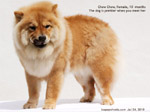 Patient: Chow Chow, female, 10 months old, 18kg.
39.7C (due to car ride and excitement, vomiting inside
the car. Don't spay till 4 hours later). She likes to
chase cats when exercised outdoors. Well groomed. Patient: Chow Chow, female, 10 months old, 18kg.
39.7C (due to car ride and excitement, vomiting inside
the car. Don't spay till 4 hours later). She likes to
chase cats when exercised outdoors. Well groomed.
Last Estrus: 3 months ago. This means that there
will be less bleeding when the dog is spayed 3 months
after the heat.
Anaesthesia: Domitor 0.25 ml IV although 0.3 ml
should be OK too. Then isoflurane gas mask and intubate.
IV saline drip given.
"Emergency drugs are to be given inside the IV drip," I
explained to Ms Lai, the young intern who wants to study
to be a vet. "But the best way is to prevent emergencies
from happening by having one assistant monitoring the
breathing bag, checking the eyelid reflexes and gum and
tongue colour every few seconds. Equipment like ECG,
pressure measurement, breathing sound measurement and
others are useful but nothing can be beat a competent
focused assistant."
Ms Lai already has a degree but she intends to be a vet
and is doing a 2-month internship at Toa Payoh Vets. She
seems passionate about veterinary medicine and so I
explained much about the behaviour and medical and
surgical problems to her the new world of dogs and cats,
rabbits and hamsters and other small animals to her.
"Old man James used to be my assistant," I said to Ms
Lai. "But now he is 75 years old and so he can only
observe the breathing bag. When the dog under
anaesthesia stops breathing, the bag will stop moving.
If the assistant only observes the bag and nothing else,
it may not be sufficient or too late. He has to observe
the mucous membrane colour and check the eyelid reflexes
as well as observing the rotation of the eyeball
downwards to confirm surgical anaesthesia."
I don't know how much Ms Lai understands my explanation
as she is so new to this world of veterinary anaesthesia
and this is the first spay she is watching. My competent
assistant Mr Saw was focused on anaesthesia.
"In the case of the Chow Chow, there is no point
checking her tongue," I said to Ms Lai. "Look at her
tongue. It is naturally purplish black and so we can't
see the red colour of oxygenated tongue. We have to
check the eyelids."
There was no problem with anaesthesia. Mr Saw tends to
put on the lowest dosage to sometimes as low as 0.5%.
"It is best not to put to such low rates," I said to Mr
Saw. "The omental fat keeps popping out making it very
difficult to stitch the muscles to close the wound. 2%
gas will be sufficient for this Chow Chow. When I go to
the skin incision, you can switch off the gas as Domitor
is still sedating."
Overall, this Chow Chow had a very smooth anaesthesia. I
took out the endotracheal tube as I saw her reacting by
moving her mouth. She woke up with a head turned
sideways for a few seconds. This was normal as she was
under Domitor sedation. An Antisedan antidote would wake
her up completely but we had to clean up the wound and
apply the plaster.
Surgery:
1. Body fully stretched out.
"Stretch out the dog as much as possible," I said to my
assistant and intern. "I use a 2-cm incision and insert
the spay hook to the right and 45 degrees downwards to
hook up the ovary. From my experience, it is much easier
to hook out the left ovary. Otherwise, the vet may take
a very long time to hook out the ovary. I have seen one
new vet graduate actually sweating when he spay a big
fat mongrel as he could not hook out the ovary for over
10 minutes. If it is difficult to hook out from a small
incision, just extend the incision and it will be much
easier."
My assistant could not stretch out the left hind leg as
there was some jam in the operating table's sliding
ring. "I will use my hand to pull the left hind leg,"
the intern proposed. Well, she had ideas as she could
not manage to resolve the jam. My assistant did it.
N.B. Some vets incise around 4 cm from the
umbilical hernia scar. In this position, the ovaries are
harder to assess and the taut ovarian ligament may not
be assessed and cut so easily as in my method. The vet
has to pull the ovarian ligament to cut or rupture it
using fingers. There is a danger of bits of the ovarian
tissue retained during this difficult manipulation.
However, each vet has his own ideas and experiences.
2. Skin incision:
Approximately 1.5 to 2 cm from the umbilical scar.
3. Linea alba incision:
Remove the subcutaneous fat. Look for the linea alba.
The Chow Chow's body is compact and this 1.5 - 2 cm
incision is too small to see the linea alba clearly. But
it can be seen. Incise the linea alba. Subcutaneous fat
can be seen below this small hole.
4. Spay hook:
With one forceps holding one edge of the muscle, I
inserted the spay hook at 45 degrees to the right (dog's
head to the vet's left), tilted the hook downwards and
had to arc the hook upwards and to the left to hook out
the abdominal fat with the ovary. In this Chow Chow,
there was much omental fat. I failed the first two times
to hook out the ovary as the fat was in the way. At the
3rd time, I saw a glistening knob at one end of the
omental fat hooked out. This was the ovary. I used the
forceps to clamp a bit of the ovarian tissue and after
that, it was simple.
5. Bleeding after separation of omental fat from the
uterine horns:
As I separated the omental fat around the uterine horns,
prior to clamping the uterine body, there was a gush of
bleeding. I clamped the uterine body lower to the
bleeding area. The bleeding stopped. I ligate the
uterine horns in two locations. No bleeding. Put the
uterine stump inside the body.
6. Loosen the tautness of the body:
I asked my assistant to loosen the tight ropes around
the dog's paws so that the body is now relaxed. The rest
of the spay is as described elsewhere in my website.
7. 2/0 absorbable suture. 2 simple interrupted
stitches closed the peritoneum and the muscles. I gave
an additional 1 more stitch. Skin is closed with 2
horizontal mattress.
8. Bleeding in the skin sutures. I asked the
intern to press swab onto the bleeding area. Bleeding
stopped after 10 minutes.
9. Elastoplast bandage covered the wound. The dog
could be bathed. No e-collar as I doubt that this Chow
Chow likes e-collars. In any case, tolfedine painkillers
post-op injection and oral for next 4 days would prevent
pain and licking.
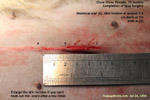 |
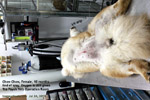 |
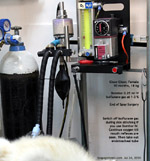 |
|
Oxygen was given for another 5
minutes to the Chow Chow after the
isoflurane gas was switched off.
She woke up without excitement, as
if from a siesta. |
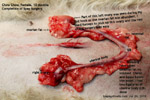 |
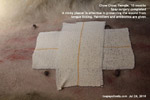 |
10. When the owner
came with her parents to take the Chow Chow home, 1 hour
after surgery, she was lying down in the air-conditioned
Surgery. "It looks like I may need to use Antisedan
antidote to wake her up fully," I said to the young
lady. I asked my assistant to bring the dog out to the
consultation room. The dog was
able to walk and even wagged her tail when she saw her
owners. So, there was no need to use the antidote.
The mother was relieved as she was worried
about anaesthesia but did not express this worry to me
earlier. I could sense it as deaths on the operating
table due to anaesthesia are common worry for many
owners.
Spaying this Chow Chow at 3 months after the last heat
was the correct timing made by the knowledgeable lady
owner. There was practically no bleeding from the
omental or ovarian fat and surgery could be completed
earlier. Still it took some 30 minutes to do the surgery.
There will be a greater difficulty of hooking up the
ovaries in the Chow Chow as she has a deeper body when
she is laid onto the operating table. If the ovary
cannot be hooked out after several trials, enlarge the
incision and use the gloved finger to feel for it. A
larger incision closes as fast as the shorter one. I
presume most Singapore owners are not too fussy about
the length of the incision in their dog spay but the vet
never knows for sure.
|
 TOA
PAYOH VETS
TOA
PAYOH VETS TOA
PAYOH VETS
TOA
PAYOH VETS